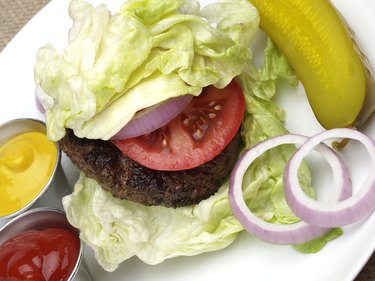
Leaves of vegetables such as lettuce or cabbage make a good bread replacement for sandwiches. Some cooks bake portobello mushrooms and slices of eggplant to use in place of hamburger buns.
Tip
Leaves of vegetables make a good bread substitute for sandwiches.
Video of the Day
Veggie Bread Alternatives
Bread is often used to enclose meat, cheese and other foods for sandwiches, but the leaves from certain vegetables make a good substitute. Raw leaves of romaine, green leaf, red leaf and iceberg lettuce make wraps that may be used in place of bread slices for sandwiches, or tortillas for tacos. The steamed leaves of collard greens or cabbage are also suitable for wraps.
Video of the Day
Read more: 10 Easy Ways to Cut Bread From Your Diet
Portobello mushrooms or eggplant slices can be used in place of hamburger buns. Cut the vegetables into slices, and then grill or bake them. They are perfect for making chicken salad or turkey sandwiches.
Another idea involves cutting slices of sweet potato and toasting them until cooked. Spread them with peanut butter, avocado or a topping of your choice.
Innovative cooks use certain vegetables as a substitute for grain products. For example, shredded cauliflower combined with a few ingredients makes a delicious pizza crust.
Other Alternatives to Standard Bread
The market offers many additional alternatives to standard types of bread. One low-carbohydrate bread is Ezekiel bread, a product made with grains, lentils and soybeans.
Another low-carbohydrate bread is cloud bread, also known as oopsie bread, says Delish. It's made of cream cheese, eggs and salt, so it's suitable for low-carbohydrate diets like the "keto" diet.
People with celiac disease are also interested in alternatives to standard bread. For people with this digestive condition, a protein found in certain grains, produces an array of gastrointestinal symptoms.
Since Ezekiel bread contains wheat, it isn't appropriate for these individuals. Fortunately, certain grain flours don't contain gluten, and some vegetables are available in the form of flour. Examples include amaranth, millet, quinoa and brown rice flours, along with bean and potato flours, according to a list from the Mayo Clinic. Nut flours are another option.
Some of these flours are found in supermarkets, while others may be purchased from health food stores. You may make your own gluten-free bread at home or buy the ready-made variety.
Choose a Healthy Peanut Butter
People on low-carbohydrate diets or vegetarian diets often eat peanut butter as a source of protein. It may seem an unlikely choice for a healthy food, but it's actually quite nutritious. Aside from protein, it contains fiber, vitamins and minerals, including potassium, notes Harvard Health. In addition, a 2-tablespoon serving of peanut butter has 12.3 grams of unsaturated fat and 3.3 grams of saturated fat, which is an acceptable ratio of healthy to unhealthy fat.
All nuts, including peanuts, confer wellness benefits when eaten. Studies indicate that individuals who eat nuts or peanut butter regularly are less likely to develop type 2 diabetes and heart disease.
Because peanut butter contains saltiness, sweetness and fat, some people have a hard time eating it in moderation. However, try to stick with the recommended serving size of 2 tablespoons.
Many brands of peanut butter contain added sugar and hydrogenated oils, which are especially unhealthy because they're a source of trans fat, says the University of California Davis Safety Services. To avoid these products, look for a brand that lists only one ingredient — peanuts.